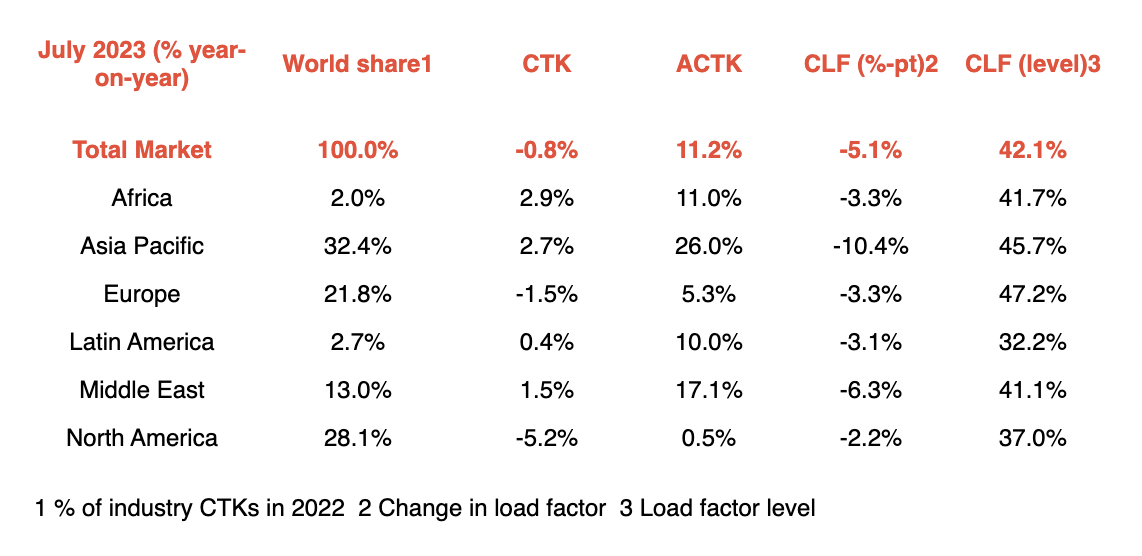The International Air Transport Association (IATA) released data for July 2023 global air cargo markets, showing a continuing trend of recovering growth rates since February.
July air cargo demand was just 0.8% below the previous year's levels.
IATA said in its report that although demand is now basically flat compared to 2022, this is an improvement on recent months's performance of -3.4%, which is particularly significant given declines in global trade volumes and rising concerns over China's economy.
It noted that capacity — measured in available cargo tonne-kilometers (ACTKs) — was up 11.2% compared to July 2022 (8% for international operations).
The strong uptick in ACTKs reflects the growth in belly capacity (29.3% year-on-year) due to the summer season, IATA said.
Several factors in the operating environment impacted July's performance, including both the manufacturing output Purchasing Managers Index or PMI (49.0) and new export orders PMI (46.4) dropping below the critical threshold represented by the 50 mark, indicating a decline in global manufacturing production and exports.
IATA said global cross-border trade also contracted for the third month in a row in June, decreasing 2.5% year-over-year, reflecting the cooling demand environment and challenging macroeconomic conditions.
It added that while air cargo growth is still lagging world trade, the gap is the narrowest since January 2022.
Significant improvement in air cargo
"Compared to July 2022, demand for air cargo was basically flat. Considering we were 3.4% below 2022 levels in June, that's a significant improvement," said Willie Walsh, IATA's Director General, adding that this continues a trend of strengthening demand that began in February.
"How this trend will evolve in the coming months will be something to watch carefully," he noted.
"Many fundamental drivers of air cargo demand, such as trade volumes and export orders, remain weak or are deteriorating. And there are growing concerns over how China's economy is developing. At the same time, we are seeing shorter delivery times, which is normally a sign of increasing economic activity. Amid these mixed signals, strengthening demand gives us good reason to be cautiously optimistic," Walsh added.

Source: IATA
North American carriers record 5th weakest month
For the period, IATA noted that Asia-Pacific airlines saw their air cargo volumes increase by 2.7% in July 2023 compared to the same month in 2022. This was a significant improvement in performance compared to June (-3.3%).
Carriers in the region benefited from growth on three major trade lanes: Europe-Asia (3.2% year-on-year growth), Middle East-Asia (up from 1.8% in June to 6.6% in July), and Africa-Asia (returning to double-digit growth of 10.3% year-on-year from -4.8% in June).
Additionally, the within-Asia trade lane also performed considerably better in July, with an annual decline of international CTKs at 7.5% compared with the double-digit decreases observed since September 2022.
North American carriers posted the weakest performance of all regions, with a 5.2% decrease in cargo volumes, marking the fifth consecutive month in which the region had the weakest performance. It was, however, a slight improvement compared to June (-5.9%).
IATA said European carriers saw their air cargo volumes decline by 1.5% year-on-year in July compared to the same month in 2022. This was, however, an improvement in performance versus June (-3.2%).
Middle Eastern carriers experienced a 1.5% year-on-year increase in cargo volumes in July 2023. This was also an improvement to the previous month?'s performance (0.6%).
IATA said the demand on Middle East-Asia routes has been trending upward in the past two months.
Meanwhile, Latin American carriers posted a 0.4% increase in cargo volumes compared to July 2022. This was a drop in performance compared to the previous month (2.2%).
African airlines had the strongest performance in July, with a 2.9% increase in cargo volumes compared to the same period in 2022.
IATA said notably, Africa-Asia routes experienced significant cargo demand growth (10.3%).